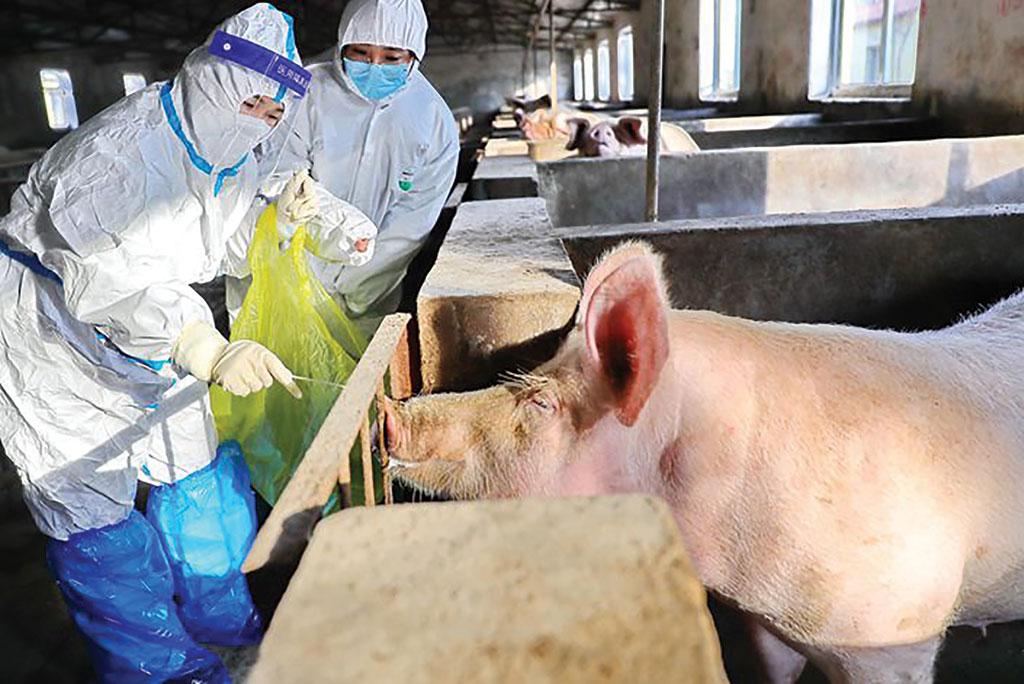
SWINE FEVER
Swine fever is an acute highly contagious disease seen in pigs. It affects pigs of all ages, with a sudden onset, high morbidity and mortality and with generalized haemorrhages.
ETIOLOGY:
Causative agent: a pantropic RNA virus belonging to Toga virus group.
The virus can be destroyed by heat at a temperature of 60-70°C.
This virus can survive in frozen pork for several months and about a month in room temperature.
SUSCEPTIBLE HOSTS:
Swine fever can affect in all breeds, sex and ages.
MODE OF TRANSMISSION:
-Direct contact with infected pigs.
-Can enter through ingestion of garbage, contaminated water and feed.
– Through inhalation it can enter into the respiratory tract.
-The most infectious materials for the transmission of this disease include, urine, nasal and occular discharges.
– The virus of swine fever will be excreted in urine for 2-3 weeks after a clinical recovery.
– Recovered pigs can act as a carrier.
– in pregnant cases, it can cross the placental barrier and can affect the foetus.
– It can also transmit through insects, flies, mosquitoes and humans.
– Indirect transmission can occur through feeding utensils, vehicles, humans etc.
CLINICAL MANIFESTATIONS:
– Per acute form
– Acute form
– Chronic form
Per acute form:
– common in young pigs
– develops quickly and can end in death within 24 hours.
– there won’t be any other clinical manifestation other than high fever (106-107 degree C) and erythematous patches.
Acute form:
– In this type of swine fever there will be a rise of temperature up to 107 degree C.
– Anorexia, constipation, offensive diarrhoea, dehydration, dullness, depression, droopiness, vomiting, loss of body weight.
– Hyperaemia of skin with purplish discoloration of snout, ears, abdomen, inner side of legs, blotching effect on ears, small vesicular lesions and necrotic lesions on edges of ears, tail, lips and vulva.
– Conjunctivitis, mucopurulent to purulent discharges from eyes, gluing of eyelids, nasal discharges.
– Central nervous system affections: wobbling gait, ataxia, tremor, convulsion, paralysis, coma.
– Reproductive disorders due to low virulent stains with fever and birth of mummified, still birth, abnormal piglets can be seen.
Chronic form:
– Morbidity:90%, mortality:60-70%
– Chronic diarrhoea
– Chronic pneumonia
– Emaciation, alopecia, blotching of skin of ear, recovery or death is seen in some pigs.
Why to take Homoeopathy:
– Quick action
– Economical, easy to administer, safe
– Only require minute dose
– Can be used for treatment and prevention of disease.
– No/least side effects
– Longer duration of action
– Action at energy level
– Environment friendly
Homoeopathic management:
– Gelsemium: swine fever with dullness, drowsiness and weakness. Bland running nose,sneezing, pain in eyes and head. Face flushed and dark red. No thirst. Trembling.
– Eupatorium perfoliatum: swine fever with bone pains which is relieved by pressure and movement. Fever followed by vomiting of bile. Chill preceded by thirst. Coryza with sneezing, hoarseness, and loose cough.
– Bryonia: when fever is complicated with pneumonia. Stitching, tearing, shooting pains aggravated by least motion. Dry hacking cough. Dry mouth with thirst for large quantities for cold water.
– Rhus toxicodendron: swine fever with chillness as cold water was poured over the body. Pain in limbs aggravated by rest and ameliorated by movement. Restlessness. Dry tongue and hard cough.
– Dulcamara: in acute state. Swine fever that comes on wet weather or change to cold weather. Sore throat, cough that hurts due to muscle soreness.
Dr. Keerthi MS
BHMS Consultant
Curewell Homoeo Pharmacy Pvt Ltd.
Aluva, Ernakulam, Kerala, India.
